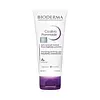What's inside
What's inside
 Key Ingredients
Key Ingredients

 Benefits
Benefits

 Concerns
Concerns

 Ingredients Side-by-side
Ingredients Side-by-side

Water
Skin ConditioningGlycerin
HumectantParaffinum Liquidum
EmollientCaprylic/Capric Triglyceride
MaskingFructooligosaccharides
HumectantPolyglyceryl-4 Diisostearate/Polyhydroxystearate/Sebacate
EmulsifyingPropanediol
SolventXylitol
HumectantZinc Stearate
Cosmetic ColorantSodium Citrate
BufferingButylene Glycol
HumectantCapryloyl Glycine
CleansingCopper Sulfate
Skin ConditioningSodium Hydroxide
BufferingSodium Hyaluronate
HumectantZinc Sulfate
AntimicrobialVitis Vinifera Vine Extract
Skin ConditioningLaureth-3
EmulsifyingAsiaticoside
AntioxidantMadecassic Acid
Skin ConditioningAsiatic Acid
Skin ConditioningLaminaria Ochroleuca Extract
Skin ConditioningHydroxyethylcellulose
Emulsion StabilisingAcetyl Dipeptide-1 Cetyl Ester
Skin ConditioningMannitol
HumectantPotassium Sorbate
PreservativeRhamnose
HumectantWater, Glycerin, Paraffinum Liquidum, Caprylic/Capric Triglyceride, Fructooligosaccharides, Polyglyceryl-4 Diisostearate/Polyhydroxystearate/Sebacate, Propanediol, Xylitol, Zinc Stearate, Sodium Citrate, Butylene Glycol, Capryloyl Glycine, Copper Sulfate, Sodium Hydroxide, Sodium Hyaluronate, Zinc Sulfate, Vitis Vinifera Vine Extract, Laureth-3, Asiaticoside, Madecassic Acid, Asiatic Acid, Laminaria Ochroleuca Extract, Hydroxyethylcellulose, Acetyl Dipeptide-1 Cetyl Ester, Mannitol, Potassium Sorbate, Rhamnose
Water
Skin ConditioningParaffinum Liquidum
EmollientSodium Chloride
MaskingZinc Oxide
Cosmetic ColorantCetyl PEG/PPG-10/1 Dimethicone
EmulsifyingPropylheptyl Caprylate
EmollientButylene Glycol
HumectantHydrogenated Polydecene
EmollientPanthenol
Skin ConditioningGlycerin
HumectantDimethicone
EmollientDisteardimonium Hectorite
StabilisingPolyglyceryl-3 Diisostearate
EmulsifyingMagnesium Sulfate
Methylpropanediol
SolventTocopheryl Acetate
AntioxidantTriacontanyl Pvp
HumectantCopper Gluconate
Skin ConditioningPropanediol
SolventPropylene Carbonate
SolventCitric Acid
BufferingGlutamylamidoethyl Indole
Skin ProtectingPolyquaternium-61
Skin ConditioningHyaluronic Acid
HumectantSilanetriol
Borage Seed Oil Aminopropanediol Amides
Skin ConditioningWater, Paraffinum Liquidum, Sodium Chloride, Zinc Oxide, Cetyl PEG/PPG-10/1 Dimethicone, Propylheptyl Caprylate, Butylene Glycol, Hydrogenated Polydecene, Panthenol, Glycerin, Dimethicone, Disteardimonium Hectorite, Polyglyceryl-3 Diisostearate, Magnesium Sulfate, Methylpropanediol, Tocopheryl Acetate, Triacontanyl Pvp, Copper Gluconate, Propanediol, Propylene Carbonate, Citric Acid, Glutamylamidoethyl Indole, Polyquaternium-61, Hyaluronic Acid, Silanetriol, Borage Seed Oil Aminopropanediol Amides
Ingredients Explained
These ingredients are found in both products.
Ingredients higher up in an ingredient list are typically present in a larger amount.
Butylene Glycol (or BG) is used within cosmetic products for a few different reasons:
Overall, Butylene Glycol is a safe and well-rounded ingredient that works well with other ingredients.
Though this ingredient works well with most skin types, some people with sensitive skin may experience a reaction such as allergic rashes, closed comedones, or itchiness.
Learn more about Butylene GlycolGlycerin is already naturally found in your skin. It helps moisturize and protect your skin.
A study from 2016 found glycerin to be more effective as a humectant than AHAs and hyaluronic acid.
As a humectant, it helps the skin stay hydrated by pulling moisture to your skin. The low molecular weight of glycerin allows it to pull moisture into the deeper layers of your skin.
Hydrated skin improves your skin barrier; Your skin barrier helps protect against irritants and bacteria.
Glycerin has also been found to have antimicrobial and antiviral properties. Due to these properties, glycerin is often used in wound and burn treatments.
In cosmetics, glycerin is usually derived from plants such as soybean or palm. However, it can also be sourced from animals, such as tallow or animal fat.
This ingredient is organic, colorless, odorless, and non-toxic.
Glycerin is the name for this ingredient in American English. British English uses Glycerol/Glycerine.
Learn more about GlycerinParaffinum Liquidum is also known as liquid paraffin. It is a type of highly refined mineral oil.
Like other oils, Paraffinum Liquidum has emollient properties. Emollients help soothe and soften the skin. By creating a barrier to trap moisture within, emollients help keep your skin hydrated.
Paraffinum Liquidum does not irritate the skin and is non-comedogenic.
Learn more about Paraffinum LiquidumPropanediol is an all-star ingredient. It softens, hydrates, and smooths the skin.
It’s often used to:
Propanediol is not likely to cause sensitivity and considered safe to use. It is derived from corn or petroleum with a clear color and no scent.
Learn more about PropanediolWater. It's the most common cosmetic ingredient of all. You'll usually see it at the top of ingredient lists, meaning that it makes up the largest part of the product.
So why is it so popular? Water most often acts as a solvent - this means that it helps dissolve other ingredients into the formulation.
You'll also recognize water as that liquid we all need to stay alive. If you see this, drink a glass of water. Stay hydrated!
Learn more about Water